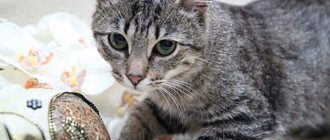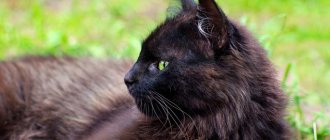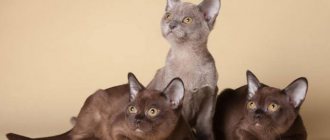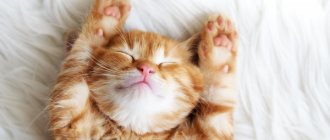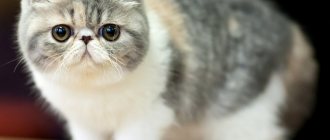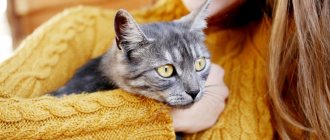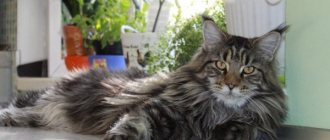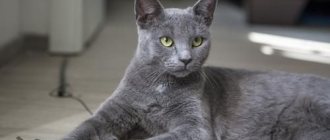Video
* We invite you to watch a video about the Chartreux . In fact, in front of you is a playlist in which you can select and watch any of 20 videos about a given cat breed by simply clicking on the button in the upper right corner of the window. In addition, the material contains quite a lot of photos. By looking at them you can find out what Chartreuse looks like.
Rate the material!
[Total votes: 1 Average: 5]
The Chartreux is a fairly rare cat breed. The simplicity of this cat is combined with elegance, and against the monochromatic background of a silky and beautiful coat, the cat’s amber eyes stand out brightly, attracting and bewitching. Let's learn more about this amazing breed, from the origins of its origins to the peculiarities of caring for these cats, having examined all the most important nuances of their life.
Photo review
The photo of Chartreuse cats shows their truly French charm, captivating with style and grace.
History of the origin of Chartreuse
This cat breed is considered quite ancient. Experts believe that the ancestors of modern Chartreuse were cats that inhabited the Middle East: Mesopotamia, Syria, Palestine. During the Middle Ages, they were brought by the crusaders to Europe, to France.
This is how the cats ended up in the Grande Chartreuse monastery. The Catholic monks living there initially observed the charter of the Carthusian order, according to which it was necessary to observe a vow of silence. It would seem that cats also adhered to this vow, making almost no sounds and meowing in a whisper. It’s not for nothing that Chartreuse cats are also called Carthusian cats.
Interesting fact: The name “chartreuse” was forever assigned to these cats back in the 17th century. In the next century (18th), the name of these cats appeared on the pages of dictionaries and encyclopedias and was listed as “blue cat.” This happened thanks to the outstanding natural scientists Buffon and Linnaeus.
The development of the breed in full began only after the end of the First World War, at that time even the first exhibitions were held. But after World War II ended, the Chartreux suffered a terrible fate - they almost disappeared completely.
This amazing cat species was saved thanks to the Léger sisters, who crossed the Chartreux with British and Persian cats, although this lost some of their purebredness. Chartreux were brought to the United States only in the 70s of the last century; American breeders wanted to cross them with British shorthair cats, but, fortunately, they changed their minds, preserving the cat's purebred.
Americans fell in love with this cat breed, and nurseries began to open throughout the country. England has long considered itself the copyright holder of the breed, because the Chartreuse is very similar to the British shorthair cat. Still, France is considered the country of origin of Chartreuse.
The cat standard was last edited in 1999 by the International Feline Association (CFA). The standard notes that chartreuse has been known since the Middle Ages.
Chartreuse: a cat whose photos are presented in nurseries
The history of the breed of these beautiful creatures goes back to the distant 16th century, when, as legend says, cats with dense blue-gray fur and a cold copper look were brought to Europe.
The animals easily got used to the environment, reproduced well and felt quite comfortable. But Europeans fell in love with cats not only for their beauty: they were bred for their warm fur, which was used for making clothes, and tasty meat. So, probably, these animals would have disappeared completely, but, as another legend states, the Chartreuse was bred by the monks of the Carthusian Order (hence the cat’s second name), who lived in the territory of Grande Chartreuse. The animals were treated with great respect and they even named a hill in their honor – Gray Cat Mountain, which still exists. Proof of this theory is a poem by one of the monks, in which he expresses his love for and admiration for a blue-gray cat.
Little is known about the further existence of the Chartreux: the cats multiplied, many lived on their own on the streets, some lived in the houses of ordinary people, where they regularly caught rodents. Over time, there were fewer and fewer animals that were still eaten.
It was only at the beginning of the 20th century that breeders became interested in this breed of cat. French chartreuse at that time practically ceased to exist. Thanks to the efforts of the breeders, already in 1928 the first representatives of the Carthusian breed were presented at an exhibition, where they were very warmly received. But no one began to seriously breed and describe this cat.
In the 70s, Chartreux began to be bred in the USA, and only then did the breed receive due attention. In the early 80s, standards were described and the breed received official status in the World Cat Federation.
Currently, there are nurseries engaged in breeding Chartreux in almost all countries of the world, but there are not many of them, so the animals are still considered rare.
Many Chartreuse breeders note the main character trait of their pet - they are very jealous. Unfortunately, it is not recommended to keep these animals together with others, since the cat will constantly attract your attention, and may even beat its opponent. If the chartreuse notices or seems to him that you are paying more attention to someone else, he may be offended, hide in a corner and worry for a long time.
Chartreuse feels quite comfortable in apartments. The cat rarely marks its territory, does not throw things around, and does not damage furniture. But the pet will find its place on its own. If you are planning to have a special house for him, then you don’t have to do this: the chartreuse will decide where he will sleep or rest. But he will defend his place. You may have to give up your favorite chair.
If there is no reason for alarm, the chartreuse is calm and calm: the cat, the description of which always indicates a balanced character, can indeed remain in the same place for a long time, carefully observing what is happening around it, but remaining indifferent. But laziness and sleepiness disappear if the pet is given the opportunity to hunt.
Carthusian cats are laconic. By nature, they have a very quiet voice and meow extremely rarely. But they purr loudly, sitting on the lap of their beloved owner. Don't be surprised if your pet chooses your bed for a night's sleep. Understand: he is firmly convinced that you cannot be left alone for a minute.
The Chartreuse cat breed, whose photos and descriptions sometimes depict harsh animals, actually loves affection and attention. Don't forget to pet your pet and talk to him quietly. But the animal may be offended by raising the tone of the voice. Even the most respectable Chartreuse cat will squint with pleasure and rub against your hand if you caress it.
The main chartreuse nurseries are located in the USA and European countries. In recent years, they have begun to appear in Russia and neighboring countries, so those who want to have a handsome blue-gray cat can sign up to purchase kittens.
The Chartreuse is still considered a rare animal. A cat, the price of which can be quite high, does not always meet the breed standards, so it is better to purchase from bona fide breeders who can provide you with all the necessary documents for the animal.
Return to the list of cat breeds with names and photographs
Like many other varieties of cats, the Chartreux breed came to Europe from the Middle East along with knights returning from the Crusades. It is documented that already in the 14th century, meaningful breeding of Chartreuse began within the walls of the Grande Chartreuse monastery, the main monastery of the Carthusian order.
The Chartreuse cat breed received its name much later - in the 17th century, and already in the next century it became commonly used for all blue cats. Even the famous Swedish naturalist Carl Linnaeus identified the Chartreuse as a separate species, the “blue cat,” in order to distinguish them from ordinary domestic cats.
In the 20th century, between the two world wars, Chartreuse breeding began seriously. For the colony of cats of this breed, which by that time had greatly thinned out, French breeders established uniform standards. Already in 1928, Chartreuse cats began to regularly take part in European cat shows.
After the Second World War, the breed's population was greatly reduced. The Chartreux cat became so rare that it could only be found from breeders. Subsequently, a new surge of interest in the breed arose in the USA, where the Chartreuse was brought in the 60s. It is there that the purest lines of the breed can now be found.
In the UK the breed is not recognized by most local cat fanciers' associations. Here, for several decades, they “promoted” the local British shorthair cat, which looks similar to the Chartreuse. In the mid-20th century, attempts were even made to unite the breeds under a single British standard. However, Chartreuse breeders managed to defend the independence of their breed. Still, the Carthusian cat differs from the British Shorthair not only in temperament and coat quality, but also in genotype.
We suggest you read: Growing live fish food
Now the Chartreux breed has been preserved in its original form, primarily through the efforts of French and American breeders. The breed standards have not changed since they were established, so the first show cats could easily perform at current tournaments and exhibitions.
True Chartreuse has a pronounced phlegmatic character. Characteristics of temperament are manifested in everything. The Chartreux adapts calmly and easily at home, gets along well with its owners, and has enviable cleanliness and calmness. Chartreuse is non-conflict and non-aggressive, quickly masters the daily routine accepted in the house, gets used to the household.
These cats spend most of the day in a relaxed state of rest. Their periods of activity are quite short, but this does not mean that Chartreux is completely devoid of hunting instincts or the desire to chase a ball. In catching rats and mice, they will give a head start to many cat breeds. These are real hunters, capable of patiently waiting for prey.
It has been noticed that Chartreuse remembers its name quite quickly and readily responds to it. In general, these are cats that are very calm about the world: not particularly sociable, but at the same time, not too shy. They are peculiar philosophers among other cat breeds. They do not enter into conflicts, do not complain about anything, and are tolerant of strangers, children and other animals.
At the same time, the Chartreux is sincerely devoted to its owner. He appreciates and loves communication, encourages in moments of sadness, and does not leave for a minute during illness. The cat does all this surprisingly unobtrusively. She does not require obligatory attention; she agrees to go about her business while the owner is busy.
The main thing in communicating with these cats is a polite attitude, various rewards and less reprimand and punishment. You need to be able to forgive your pets minor offenses and be patient, then the love and devotion of the Chartreux will have no boundaries.
The appearance of the Chartreuse is reminiscent of the British.
Let us repeat that the breed, in principle, like most other breeds, originates in the East. In France, the main population of animals was located in the monasteries of the Carthusian Order of Grand Chartreuse. Over time, the pets multiplied in the vicinity of Paris and some other regions of the country, but their numbers were still small.
Some sources claim that blue cats were considered ordinary domestic cats and were mainly kept in the houses of the poor, while others report their life only in aristocratic castles in France.
By the way, commoners got pets for mercantile purposes:
- firstly, beautiful fur was highly valued by furriers;
- secondly, people often feasted on their meat (French gourmets, apparently, love not only frog legs, but also “cat meat” for lunch);
- and thirdly, Chartreux - wonderful hunters - easily rid the house of an infestation of rodents.
Chartreux are silent by nature and have a weak voice.
Carthusian cats can be called ideal creatures for living at home: they quickly adapt to a new home, obey their owner unquestioningly, strictly follow the usual family routine, can easily tolerate transportation, and are distinguished by their meekness and integrity.
Chartreux - description of the breed
If we talk about the general description of the Chartreux, it can be noted that the cat has a fairly powerful physique. The standard marks it as primitive, i.e. it has not changed during breeding work.
The cat's body perfectly combines grace and strength, and you can add speed of reactions and agility to them. The gender differences in these cats are immediately noticeable: females are much smaller than males. The weight of males varies from 6 to 7.5 kg, females - from 4 to 5 kg. Well-developed muscles clearly appear on the stocky cat's body.
The head of the Chartreuse is very wide, in shape it resembles an inverted trapezoid. She has a high and sloping forehead, rounded and plump cheeks. The nose is straight and short in length and width. The bridge of the nose is located at the level of the cat's eyes and is of moderate severity. The entire shape of the muzzle protrudes slightly forward. The neck of the Chartreux is short, but very massive; in combination with the round, thick-cheeked face, the cat looks good-natured and seems to be smiling. The ears are of medium size, set vertically and high. The eyes are large and not endowed with a characteristic squint.
The iris can be colored in the following shades:
- Reddish yellow;
- Yellowish-brown;
- Orange-brownish;
- Amber;
- Golden;
- Bronze;
- Bright orange.
The last eye color is the most valued. The length of the cat's tail is less than the length of the entire body. At the base it is greatly thickened, towards the end it becomes narrower; experts note its mobility and special flexibility. Chartreux cannot be called long-legged; their limbs have average parameters, they are quite strong and straight, and the front legs are smaller than the hind legs.
Features of the appearance of Chartreux cats
The Chartreuse breed standard places more demands on color and eye color.
Table: appearance of Carthusian cats
| Body parts | Description |
| Head | Quite large, the lower part is slightly wider than the upper. In adult cats, the cheeks stand out significantly. |
| Nose | Coat color lobe. The nose is wide. |
| Forehead | The forehead is not particularly convex, but blends smoothly with the nose. |
| Podsniki | The mustache pads are well defined. Together with chubby cheeks they create the impression of a smile. The pinch is not visible. |
| Neck | Short and large, smoothly turning into the occipital part. |
| Ears | They are of medium size and stand upright with a slight tilt forward. |
| Eyes | Large, round, very expressive, set close to the bridge of the nose. Therefore, the muzzle appears small compared to the head. Color: honey, copper-yellow, yellow-orange. Once born, kittens have blue eyes, gradually changing to gray. And only when fully mature do they acquire a yellow color. |
| Body | Despite its small size, the body is massive and has strong bones. The width of the chest and pelvis are the same. The back is straight. |
| Paws | In comparison with the powerful body, the paws seem more graceful and short. The feet are wide with strong claws. |
| Tail | Thick, medium length, tapering and rounded towards the end. |
| Wool | Soft and silky in young individuals; very dense, reminiscent of a plush toy in older ones. These cats have equal lengths of undercoat and main coat, resulting in a double, dense coat. Adult males may even develop folds on their necks. |
| Color | The hallmark of the breed is an even color without transitions or shadows. Color: Various gray options. Preference is given to light gray tones with glitter. But due to the peculiar texture of the coat, the impression of a blue color is created, which cannot be conveyed through photography. Young kittens may have some pattern on their fur, which disappears as they grow older. This is not a disadvantage. The tips of the hairs are slightly silvery. The nose and paw pads must have a gray tint. |
| Weight | The weight of an adult cat is between six and seven kilograms; cats on average weigh one kilogram less. |
Features of the breed that are considered disadvantages:
- A sharp bend in the nose: because of this, its tip appears upturned or snub-nosed.
- Wide muzzle.
- When palpated, you can find flaws in the structure of the tail.
- Due to the close proximity of the eyes, the impression of constant dissatisfaction is created.
The following defects lead to rejection:
- White medallion or other spots, including on the skin.
- Visible tail break.
- Green eyes.
- Lameness due to luxation of the kneecap.
Photo gallery: appearance features of Chartreuse cats
The head of the Chartreux is large, with round cheeks, without pinch
Cats of this breed have neat small ears that stand upright with a slight tilt forward.
The body of a chartreuse cat is medium in size, quite massive with heavy bones and strong muscles.
The tail of the Chartreuse is proportional to the body, slightly rounded at the end.
Kittens are born with blue eyes, which gradually turn gray and then take on their final color.
Chartreux cat personality
The character of Chartreuse cats is very phlegmatic: they calmly react to changes in the environment, are clean and easy to get along with other pets, and do not show aggression towards others. Sometimes they say that this cat learned the ability to remain silent from the Carthusian monks: it very rarely meows, sometimes it can express gratitude to its owner with a quiet purr. Chartreux dogs spend most of the day in a dormant state. But there may be periods when they want activity and play. No wonder the monks valued this breed for its ability to catch rodents; hunting instincts do not disappear anywhere and can manifest themselves if necessary.
True Chartreuse has a distinctly phlegmatic character.
Many owners note that Chartreuse dogs are good at learning: they quickly get used to their name and learn the rules of behavior in the house. During games, they can behave like dogs: find and bring a toy to the owner.
There may be periods when Chartreuse cats want activity and play.
Chartreux dogs are loyal to their owner. They are not intrusive, do not require affection, but are silently present and supportive at any time. To become a friend and owner of this cat, you need to learn to respect it. Carthusians prefer not to communicate with strangers, but there are exceptions, as can be seen in the proposed video.
Video: everything about the Chartreuse breed
Popular Chartreuse colors
The elegant and wonderful coat of the Chartreuse can be confidently called a cat’s calling card, because it is thanks to it that this breed is valued by many cat lovers. In general, Chartreuse cats are short-haired, but it is rare to find cats with medium-length hair. Cat fur is thick, fluffy, silky, and incredibly pleasant to the touch.
This cat breed is characterized by the presence of a rather densely packed undercoat, which makes the Chartreuse look elite, stately and attractive. The undercoat also has practical significance, protecting the mustache from cold and wind.
Interesting fact: Despite the fact that the fur of Carthusian cats is not long, they shed quite profusely, which should be kept in mind for those who are prone to allergic reactions.
There is no need to say too much specifically about the color of Carthusian felines, because it is quite laconic and uniform, but this is its nobility, a special chic that gives the cats incredible attractiveness.
The coloring of chartreuse is monochromatic blue; it can vary, having certain distinctive shades, ranging from light tones to dark, gray-blue, shimmering with silvery highlights in bright light. Some experts describe the coat color of these cats as a cool shade that can vary from blue-gray to lavender tones.
Other colors and shades are not provided by the standard. Also, there should not be any specks of white or dark colors on the fur, stripes should also be excluded, this will be considered a defect. The cat's nose in Chartreuse is dark graphite in color, and the color of the pads on the paws is grayish-pink.
Mr. Cat explains: color
A distinctive feature of Chartreuse is the presence of two-layer fur. The upper level of the coat is quite long and silky, and the inner layer is short, dense, able to repel water, the undercoat. Due to this structure, the density of the fur is simply amazing; it looks like the cover of fur-bearing animals.
The color can vary from almost silver to dark gray, and the lighter the color of the animal, the higher its price.
In addition to the coat color, all skin of such a pet should have a gray color, this applies to the nose and paw pads.
Character and habits of Chartreuse
Naturally, each cat has its own character, in which individuality is visible, but, nevertheless, some common features are inherent in this breed, let's try to analyze them. There are three particularly pronounced qualities that Chartreuse is endowed with.
This:
- Jealousy;
- Equilibrium;
- Modesty.
Let's look at each of these three points in more detail. As for jealousy, this is precisely the trait that many owners note in Chartreux dogs. Cats will never put up with the fact that another pet will live in the house, they should feel like they are one and only, so it is not at all easy for a Chartreuse to get along with another pet, this most often does not work out, although there are exceptions. Chartreux children, having spoiled themselves, are treated with love and warmth.
Although Chartreux are playful, they know when to stop everything, they are calm and taciturn. Cats have a very quiet voice, so you shouldn’t expect violent meows from them; it seems that equanimity and balance are in their blood. Chartreuxes never get into trouble and try to avoid conflict situations. They endure various changes and inconveniences (for example, a change of place of residence). These mustaches can adapt even to prolonged loneliness.
As for modesty, it suits a Cartesian cat (more precisely, it suits its face). They are very devoted to the owner (precisely one person), having chosen him, cats become constant faithful companions, but stay a little distant so as not to seem annoying once again, Chartreux never impose themselves, showing their independence and nobility. Cats are loyal to strangers, do not show aggression, and behave quite peacefully and reservedly.
Chartreux are by nature tireless hunters, their vigilance and hearing are excellent. They perceive sounds that humans cannot understand. Cats immediately go in search of the source of this sound, sneaking up unnoticed and silently, the next stage is a well-aimed throw, with the help of which the prey (and this, most often, a mouse) is firmly pinned down. Long games with a caught trophy are not typical for Chartreuse.
Chartreux are real intellectuals; scratching everything, spoiling and breaking things is not their thing. Cats are very clean. Adult chartreuses are never averse to being lazy and taking a nap for an hour or two, which is quite typical for any ordinary, mongrel cat.
Maintenance and care
There are no special requirements for keeping and caring for a pet. However, the following points should be taken into account:
- Cats are inactive, so wide spaces and multi-story structures are not required;
- There is no point in organizing a bed or shelter for a cat, since the pet will choose where and how it is comfortable for him to sleep. It will not be possible to change his decision;
- There is no need to restrict the animal’s movement around your home. In an attempt to get to the place it needs, the animal may get injured;
- Regular walks will improve your cat's well-being and mood. The opportunity to hunt and get some fresh air is essential for cats of this breed;
- The process of washing Chartreuse can be inconvenient . The wool is so thick that it does not get wet immediately, and the process of washing out the shampoo and drying the hairs will take a long time. Therefore, this breed is washed once every 6 months;
- Your pet should be brushed weekly. And when the molting process occurs - daily;
- The animal's eyes should be cleaned every day, and its ears once every 2 weeks;
- Chartreuse cats often suffer from tartar, so you should regularly brush your pet's teeth with a special toothpaste.
The animal loves to run and climb
There is no need to restrict his movements
Interesting facts about Chartreuse
There are many interesting stories and facts about such amazing cats, which we will try to present, choosing the most fascinating ones. Maybe they will encourage many to get themselves such an attractive mustachioed pet.
So, the most interesting facts about Chartez cats:
- Chartreux is considered a fairly ancient breed; scientists have proven that they were first mentioned in the 16th century;
- Chartreux cats are similar to British Shorthair cats, so the breeds can easily be confused. Until 1977, these two cat varieties were considered one breed, but after they became separated, thus emphasizing the fact that these are different types of cats. The French treat Chartreuse as a national treasure;
- Even Charles de Gaulle had a mustachioed favorite Chartreuse; he greatly appreciated his refined appearance and the habits of a real aristocrat;
- Surprisingly, today the majority of purebred Chartreuse live on the American continent, and not in France;
- In addition to the cat breed, “chartreuse” is also called a famous liqueur infused with medicinal herbs. Its recipe was also developed by the monks of the Chartreuse monastery;
- The color of the Chartreuse's undercoat differs from the overall tone of the coat; it looks darker. The skin of the animal also has a bluish color;
- Under severe stress, Chartreuse cats may begin to lose their hair, so you need to take care of the cat’s nerves so that the animal does not turn into a Sphynx cat;
- They say that the Chartreux owes its silence to the monks of the same monastery, who kept a vow of silence, and the mustachioed pets also began to follow this principle, accustomed to meowing rarely and quietly;
- In France, on the territory of the Savoie department, there is a mountain named after the Chartreuse “Mountain of Gray Cats”;
- The Carthusian monks dedicated many poems to these amazing feline creatures.
Owner reviews
According to the majority of Chartreuse owners, representatives of this breed, which is quite rare in our country today, are real aristocrats, distinguished by their restraint and elegance, very good manners and innate delicacy. When surrounded by family, such pets behave quietly, very calmly and absolutely unobtrusively. But at the same time they remain unsurpassed hunters of various rodents.
Due to the tendency of Carthusian cats to become obese, such pets are in dire need of regular physical activity and sufficient movement. A closed space is not at all suitable for this purpose, so veterinarians recommend often walking representatives of the Chartreux breed outside. In this case, the cat owner needs to take care of regular and effective preventive treatment of the coat with special products against ectoparasites.
Experts advise that you approach the purchase of a Chartreuse kitten very carefully, preferably professionally, because according to the current rules on breeding such cats in France and America, hybridization of this breed is strictly prohibited, including any interbreed matings. However, unreliable breeders neglect such requirements, which may well become the main reason for the degeneration of a rare and beautiful cat breed in the future.
Pros and cons of Chartreuse
Like any other animal, Chartreuse has its own characteristics. Many owners do not notice any shortcomings in these cats, because they adore them immensely. Looking at Chartreuse from the outside, you can see both the pros and cons; we will try to list them. This may help those who are planning to get such a cat.
Cat's virtues:
- Possessing a calm and obedient character;
- Boundless devotion to the owner;
- Magnificent and noble appearance;
- Delicacy and unobtrusiveness, chartreuse certainly won’t bother you;
- A quiet voice that you rarely hear;
- Cleanliness;
- Presence of intelligence and intellectual development;
- They get along well with children and don’t mind tinkering with them;
- Magnificent and passionate hunters;
- Unpretentious regarding care;
- Avoid conflicts;
- Independent and adapt well to any new conditions;
- They are the owners of fairly good health.
Disadvantages of the breed:
- Rarity, and therefore overpriced;
- Subject to heavy and frequent shedding, which can cause allergic reactions;
- Very similar to the British Smooth-haired;
- They are often obese, so you need to carefully monitor your diet;
- They may show excessive autonomy and independence;
- They do not like long and excessive caresses;
- Jealous of other pets, it is preferable that there are none at all;
- They do not like to live in a specific designated place, considering the entire house to be their territory and moving freely around it;
- Aversion to water procedures, which are not easy to carry out in autumn.
Breeding Chartreux
Chartreux become sexually mature at the age of one year or even closer to one and a half years. It has been noticed that the maturation of cats is slightly delayed compared to females. The main thing for mating is the moment of selecting a worthy partner, which is very difficult due to the great rarity of these cats.
An important factor here is not only the presence of an excellent pedigree, but also the excellent health of both mustachioed partners. It’s worth noting right away that breeding Chartreux in our country is not possible, because these cats are mainly bred in the USA and France; breeding individuals are not exported outside these countries, so kittens that are already castrated or sterilized come to Russia. You can find out below how the mating process works in the above-mentioned countries.
For mating, the cat is brought to the territory of the male so that the latter feels confident and is not afraid of anything. Experts recommend leaving the female to stay with the cat for a couple of days to ensure a guaranteed pregnancy of the cat, which lasts for two months. Usually, there are 2 - 4 kittens in a litter, very rarely there are 5 babies. Most often, Chartreuses themselves cope well with all the difficulties associated with childbirth, so it is quite possible to do without medical help, of course, if no complications are observed.
In the first weeks of life, kittens need only maternal warmth and breast milk. At this time, only the mother cat should take care of the babies’ nutrition, and owners should only take care of feeding her, providing all the necessary vitamins and minerals. Kittens become sighted between 7 and 10 days of age; their development rate can be called moderate.
Closer to the age of one month, they are already quite capable of going to the litter box. At six weeks they begin to wash themselves, communicate more vividly with each other, behaving like adult relatives, at the same time they acquire their noble and refined coloring. Three months of age is considered the best time to hand over grown babies to new owners. It should be added that the average lifespan of Chartreuse is 12 years, but there are specimens that lived up to 16.
How to choose the right kitten
Chartreux are quite rare and expensive animals. Therefore, it is advisable to buy kittens of the Carthusian breed in specialized nurseries or from trusted breeders with a good reputation. Before purchasing, it is important to make sure that small chartreuses are kept clean and have all the necessary documents.
Having dealt with the papers, you can pay attention to the appearance of the Carthusians themselves. The purebred three-month-old kitten has a proportional, strong build, orange eyes and the correct gray-blue color.
A healthy little Chartreux should have clean ears, smooth skin without scratching, a soft belly and a good appetite. He shows no signs of cowardice and is actively interested in everything that happens around him.
Kitten care
Conscientious breeders begin transferring small Chartreux dogs to new owners after they are 3 months old. By this age, Carthusian kittens not only know how to eat on their own, but also know a tray with a scratching post. Therefore, new owners can only show the pet the location of the toilet, scratching post and bowls of food and water.
The little Carthusian is no less curious than a kitten of any other breed. To prevent him from harming himself, wires, indoor plants, household chemicals, and small and fragile objects are hidden from him.
Caring for Chartreuse
Carthusian cats cannot be called picky; they do not require any privileged conditions, they are unpretentious in care, which is good news. Naturally, it is necessary to take care of mustachioed pets by carefully monitoring their appearance, behavior and carrying out certain hygiene procedures.
Important fact: You should definitely pay attention to the cat's fur coat; to do this, you need to comb it at least once a week, or more often, cats really like this massage. When Chartreuse sheds, this must be done constantly and with a coarser brush.
Cat teeth are also cleaned weekly using a special, coarse brush and paste for animals. Such dental procedures not only remove food particles, but also eliminate the appearance of tartar. Cat's eyes also require care; they need to be washed with tea or a special product using a soft cloth or cotton pads, the main thing is that they do not leave lint.
A couple of times per month you need to inspect your ears, wiping them from the inside with a cotton pad dipped in water. This is not to the liking of the Chartreuse, so you need to show remarkable skill and accuracy. Cats should have their nails trimmed once a month using a special nail clipper; only the very ends need to be trimmed.
With water procedures, things are not so rosy; it is not recommended to bathe Chartreuse dogs more than once or a couple of times a year, and doing so is extremely problematic. Cats hate bathing and are very impatient with it and can become aggressive. It is not easy to wash their tightly packed wool, and it takes a long time to dry.
As for arranging a specific cat’s place in the home, Chartreux does not need this; they will independently choose an area for relaxation, because restrictions and closed doors irritate them. Carthusian cats love free movement around the house, because they consider it their property. Chartreuse dogs can be trained to walk outside, they simply love it, but they prefer independent movement rather than using a leash or harness, although they also get used to these accessories.
Vaccinations and antiparasitic treatment
All domestic cats are susceptible to viral infections. To protect the Carthusian from premature death, he is regularly vaccinated:
- from calcivirosis;
- rhinotracheitis;
- panleukopenia.
The Carthusian kitten is first vaccinated at the age of 7-8 weeks. After 4 weeks, the vaccination is repeated, but with an anti-rabies component. Subsequently, the Chartreuse is vaccinated annually.
To protect the Chartreux from diseases carried by parasites, it is regularly treated for fleas and helminths. Antihelminthic tablets are given to Carthusian cats once every six months and repeated after 10-14 days.
For flea treatment, special drops and shampoos are used. And if the Chartreux regularly goes outside, he is additionally protected with an anti-parasitic collar.
Chartreuse diet
Chartreux cats are not picky about food, cats have an excellent appetite, and this breed is prone to obesity. Therefore, experts recommend feeding cats with high-quality dry food, where all the necessary vitamin and mineral elements are balanced. Of course, only the owner decides what his pet’s food will be: natural or dry food (you cannot combine).
Food from the human table is not suitable for Chartreuse. Salt, spices, fatty and fried foods are contraindicated for them. Pork, smoked meats, and all sorts of highly salted junk foods should be excluded from the cat’s menu.
First of all, Carthusian cats should be given:
- Lean rabbit meat;
- Chicken;
- Turkey;
- Beef.
All of the above meat products are best boiled or thoroughly frozen. It is not often that cats can be treated to boiled sea fish; it is better that there are as few bones in it as possible. Instead of cereal porridges, experts recommend vegetable side dishes for these cats; Chartreuse cats are not averse to eating pumpkin, zucchini, cauliflower, and zucchini.
Fermented milk products, such as fermented baked milk or kefir, are also very useful for mustaches, but it is better to avoid milk, it is poorly digested and can cause stomach upset. Boiled chicken or quail eggs should be given once a week. They are especially useful for kittens, who are also fed cottage cheese.
There is no need to overdo it with portion sizes, do not fall for the tricks of cats looking at you with hungry eyes, remember the tendency to be overweight. Of course, you shouldn’t forget about water; access to it should be around the clock, especially if the cat eats dry food. It is better to use bottled water, but tap water will do, you just need to let it sit for about 6 to 8 hours.
Feeding the cat
Chartreuse are not picky eaters and eat both commercial and natural food with equal appetite. Therefore, when choosing the type of food for a Carthusian cat, you can be guided by the breeder’s recommendations and your own convenience.
Complete diet
With an industrial type of food for a Carthusian cat, they buy high-quality premium or super-premium food, which does not contain questionable components such as soy, dyes and preservatives.
The following brands are best suited for Chartreuse:
- Arden Grange;
- Royal Canin;
- ProPlan;
- Acana.
Important. Dry-fed Carthusians must have 24-hour access to drinking water.
The diet of Chartreux cats, which consume natural products, should consist of lean meat. Also, the menu of cats of this breed must include:
- offal;
- dairy products;
- boiled vegetables;
- porridge with water;
- eggs.
Chartreuse cannot be fed with sweets, onions, garlic, sausages, river fish, pork, legumes or any leftovers from the owner's plate.
Feeding frequency
Small Carthusian kittens eat less and more often than adult representatives of the breed. Therefore, the feeding regimen depends on the age of the animal:
- up to 6 months – 4-5 times a day;
- 6-12 months – 3 times a day;
- from 12 months – 2 times a day.
Vitamins and minerals
In the body of a Chartreux that eats natural food, a lack of microelements may occur. To compensate for this deficiency, the Carthusian is given vitamins in courses twice a year. When selecting mineral complexes, the veterinarian’s recommendations and the body condition of a particular representative of the breed are taken into account.
On a note. Carthusian cats are prone to joint diseases. Therefore, they are recommended to additionally give chondroprotectors.
Diseases and health problems
Carthusian cats have a strong immune system, so they are not susceptible to attacks from various viral diseases, but they do have some congenital problems. These include dislocations of the kneecaps, which are the most common. This can lead the cat to lameness and weakness of the hind legs; such cats are discarded from the reproduction process.
Important fact: A disease such as hip dysplasia is also characteristic of Chartreuse, it can be completely stopped or its progression can be significantly slowed down if you consult a veterinarian in time.
Felines can suffer from gingivitis, which can be dangerous to their teeth, so weekly brushing and regular checkups are essential. Every year, the veterinary clinic needs to remove tartar, if any. Don’t forget that Chartreuse cats are susceptible to obesity, so choose their diet carefully and do not overfeed, because excess weight in cats can also affect the cat’s cardiovascular system, which is very dangerous.
In general, chartreuses are very strong, quite hardy, strong not only in body, but also in spirit. It’s not for nothing that they lived in the monastery from ancient times. Of no small importance for the cat’s health is the care of the owner, which consists not only of constant monitoring of the pet, but also of timely vaccination and deworming procedures so that the mustachioed pet feels needed, happy, and most importantly, healthy.
As you know, the best talisman against all illnesses is their prevention, thanks to which you can identify the disease at an early stage, easily cure it, and in many cases, ailments and problems can be completely avoided.
Education and physical activity
Chartreux are very smart and quick-witted animals. They are easy to train and quickly get accustomed to the rules established in the house. Smart Carthusian cats easily get used to the tray and scratching post. But they will not follow commands like a dog.
Chartreuse cannot be called active and temperamental animals. Lazy Carthusian cats will prefer to sleep. Therefore, it is not necessary to equip play complexes for representatives of the breed.

